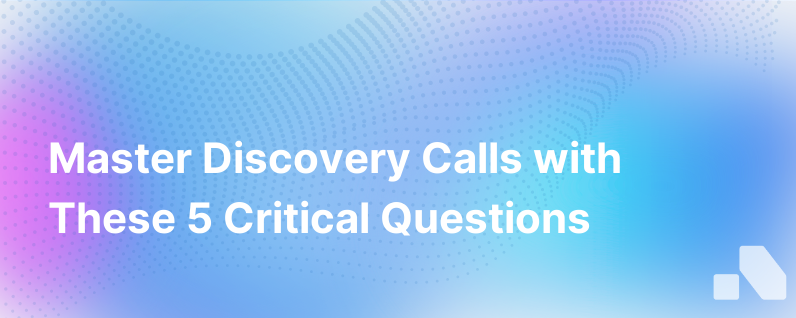5 Questions To Crush Your Discovery Calls
Published on August 19, 2023 by Sawyer Middeleer
Discovery calls are the cornerstone of any successful sales process. They set the tone for the relationship with your potential client and possibly sow the seeds of a long-term partnership. Mastering the discovery call requires balancing active listening skills with the right questions that probe deep into the clients’ needs and challenges.
As a sales professional, asking the right questions is essential. But not all questions are created equal. Here are five powerful questions designed to crush your discovery calls and help you glean the insights you need to tailor a compelling pitch.
1. "Can you tell me about the biggest challenges you're facing in [specific area or process]?"
This open-ended question puts the spotlight on the prospect's pain points. It is specific enough to prevent vague responses yet broad enough not to pigeonhole the conversation into one area too soon. It encourages the potential client to lay out the ground realities they face daily, which gives you tangible problems you could solve.
An ideal response from a prospect would give you the full context around their challenges, perhaps even revealing deeper issues that were not initially apparent. You can enhance this question by throwing in a little homework you've done earlier about their industry and competitors, showing that you understand the space they operate in.
2. "How do these challenges impact your overall business goals?"
This question aligns the problems identified previously with the higher-level business objectives. It helps transition the conversation from tactical pain points to strategic implications. By linking the problems to business goals, you demonstrate a deeper understanding of their priorities and can position your solutions as not just nice-to-have, but crucial for their overarching success.
Prospects will often reveal more about their internal processes, timelines, and pressures in their answers, providing you with insights into the internal workings of their company. These can identify opportunities to align your product or service more closely with the outcomes they are striving to achieve.
3. "What solutions have you tried previously, and how have they worked out for you?"
With this question, you uncover the prospect's history of problem-solving attempts, which sets the stage for you to introduce a new, more effective solution. This question also uncovers their buying patterns, preferences, and what they value in a solution. Have they always gone for the cheapest option? Do they value support and aftercare service? Have they been disappointed by overpromising and underdelivering vendors in the past?
Listen closely to what worked and what didn’t, to avoid proposing solutions similar to those that have failed them before. This question is essential because it helps you understand the prospect's readiness for change and reveals potential objections you may need to address later in the sales cycle.
4. "What does the ideal solution look like from your perspective?"
Instead of you pitching what you think they need, let the prospect paint the picture of their ideal outcome. This question not only helps you understand their expectations but also makes the prospect visualize a future where their problems are solved. This visualization process can strengthen their emotional connection to finding a solution, increasing the potential of them purchasing, especially if your offering fits that vision.
Their answers provide a success criteria blueprint for your offering. Tailor subsequent conversations to show how your product or service aligns with their 'ideal' as closely as possible.
5. "Who else in your organization will be involved in the decision-making process?"
Identifying the decision-makers and influencers is crucial in the B2B sales process, which often involves several stakeholders. This question helps you map the prospect's organizational structure and understand who you will need to convince. It is a foundational question for developing a multi-threaded engagement strategy and can save you from being blindsided by an unexpected veto from an unseen stakeholder later on.
As a follow-up, delve deeper into understanding each stakeholder’s unique concerns and criteria. This way, you can tailor your messages and demonstrations to resonate with multiple people in the company, thereby building a broader base of internal support for your solution.
Wrapping it up
Successful discovery calls are much more than a Q&A session; they're an opportunity to align with your prospect's objectives, empathize with their challenges, and start crafting a solution together. The quality of your questions can make or break the conversation, and ultimately, your deal.
In-depth knowledge about the prospect, active listening, and adaptability in the face of new information are key to leveraging these questions effectively. Remember, each answer holds nuggets of critical information that can gear you towards a tailor-made solution—which is where platforms like Aomni can empower you by providing actionable competitive insights and personalized sales content instantly.
An efficient discovery process not only paves the way for a sale but also fosters trust, laying the groundwork for a durable and prosperous business relationship.
Remember, each conversation is a stepping stone. So arm yourself with these questions, listen intently, and ready yourself for the full sales journey ahead. With Aomni, you'll be equipped to make that journey more insightful and less effortful, and that's a recipe for sustained success in today's competitive B2B landscape.